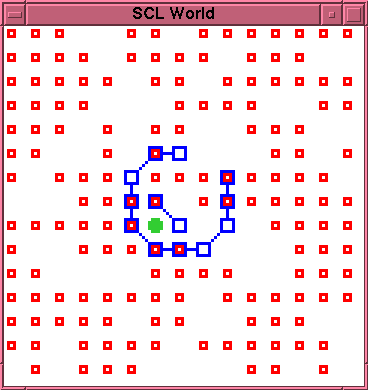
 6.1 Run 1-1
6.1 Run 1-1
On this run, the initial rupture of the membrane occurs relatively early, at time 31. Just one L particle has been produced within the membrane by this time. However, since this means the particle is still mobile, there is at least some possibility that it may drift to the rupture site and effect a repair. A second L particle is produced at time 63, thus improving the possibility of a repair. However, at time 69, these two L particles bond to each other, thus becoming immobile, and unavailable to drift to the rupture site. Moreover, they are located in such a position that the K particle is blocked in all four directions. This configuration is illustrated in figure 5. Not only is the K particle now also effectively immobile, but, again, there is no space available adjacent to it to permit further production of new L particles. Thus, there is no possibility of repairing the existing rupture. As with run 1, the initial entity has clearly already irreversibly degenerated.
Figure 5: Experiment 1, Run 2, Time 069.

 6.1 Run 1-1
6.1 Run 1-1
Copyright © 1997 All Rights Reserved.
Timestamp: Wed Feb 5 21:58:53 GMT 1997